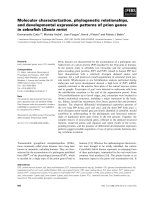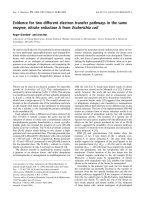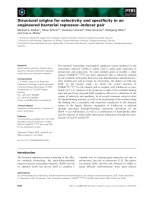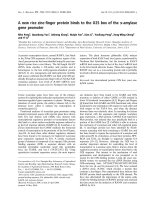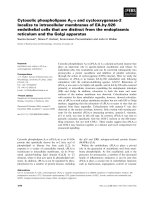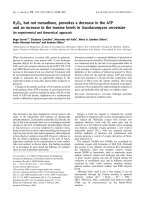Báo cáo khoa học: "Embryonic Intermediate Filaments, Nestin and Vimentin, Expression in the Spinal Cords of Rats with Experimental Autoimmune Encephalomyelitis" pdf
Bạn đang xem bản rút gọn của tài liệu. Xem và tải ngay bản đầy đủ của tài liệu tại đây (137.03 KB, 5 trang )
J O U R N A L O F
Veterinary
Science
J. Vet. Sci. (2003), 4(1), 9-13
Abstract
2)
Intermediate filaments, including nestin and vi-
mentin, are found in specific cell types in central
nervous system (CNS) tissues, particularly immature
glial cells and multipotent progenitor cells. In the
present study, the expression patterns of nestin and
vimentin in the spinal cords of rats w ith experimental
autoimmune encephalomyelitis (EAE) and the response
of cells containing filaments against acute autoim mune
injury were examined by immunohistochemistry.
Nestin immunostaining w as only w eakly detected
in vascular endothelial cells but not in any cell type s
in the spinal cord in normal and adjuvant-immunized
rats. At the peak stage of EAE, nestin-immunoreativity
w as recognized in some astrocytes in the gray matter
and w hite matter. Vim entin was im munopositive in
some astrocytes and m acrophages in EAE lesions,
w hile vimentin w as normally detected in ependymal
cells of central canals in the rat spinal cords.
We postulate that normal anim als may contain
multipotent progenitor cells in the spinal cord pa-
renchym a as w ell as in the subpial lesion and epen-
dyma. Multipotent progenitor ce lls may activate to
transform into necessary cells, including neurons,
astrocytes or oligodendrocytes, depending on CNS
needs. Appropriate control of progenitor cells in the
injure d CNS is an alternative choice for CNS
remodeling.
Key words:
autoimmune encephalomyelitis, nestin, vimentin,
astrocyte
Introduction
Experimental autoimmune encephalomyelitis (EAE) is an
*
Corresponding author: Tae-kyun Shin
Department of Veterinary Medicine, Cheju National University, Jeju
690-756, Korea
Tel: +82-64-754-3363; Fax: +82-64-756-3354
E-mail:
autoimmune disease of the central nervous system (CNS)
that is used to study human demyelinating diseases such as
multiple sclerosis [10]. The clinical course of EAE is
characterized by weight loss, ascending progressive paralysis,
and finally, spontaneous recovery. These steps are matched
by an inflammatory response in the CNS, which is cha-
racterized by the infiltration of T cells and macrophages,
and the activation of microglia and astrocytes at the peak
stage [11, 12]. Brain cells, including astrocytes, react to the
inflammatory cells infiltrating in the CNS and encase the
damaged lesions [8]. During this process, these cells may
transform from the resting stage to the activation stage. In
a few cases, it has been postulated that precursor cells may
activate and transform into neuronal or glial cells around
the injured lesion.
Intermediate filaments are composed of different filament
proteins depending on cell type, developmental stage, and in
some cases on activation stage. Three intermediate filaments,
nestin, vimentin, and glial fibrillary acidic protein (GFAP),
are found in specific cell types in the CNS, particularly
astrocytes. Nestin and vimentin are the main intermediate
filaments in immature astroglial cells, whereas maturing
astrocytes contain vimentin and GFAP [6]. Replacement of
nestin by vimentin and GFAP occurs during the maturation
or differentiation of multipotent neural precursor into
astrocytes or neurons, particularly during embryonic deve-
lopment [13].
Of the three intermediate filaments, expression of vimentin
and GFAP is well documented in reactive astrocytes in CNS
tissues, including in experimental brain injury [2], autoimmune
encephalomyelitis [4], and neurodegenerative diseases such
as amyotrophic lateral sclerosis [14, 15]. It has been suggested
that nestin-expressing cells reflect a sustaining active stage
of embryonic precursor cells, and are involved in repairing
damaged CNS tissues. This phenomenon is one of the major
features of EAE tissues, and is characterized by cellular
infiltration of inflammatory cells, encasement of inflammatory
lesions, and finally, reactive astrogliosis [8]. During recovery
from EAE inflammation, it is likely that both nestin and
vimentin are dynamically changed.
The aim of this study is to examine the expression of
Embryonic Intermediate Filaments, Nestin and Vimentin, Expression in the Spinal
Cords of Rats with Experimental Autoimmune Encephalomyelitis
Tae-kyun Shin*, Yong-duk Lee and Ki-bum Sim1
Department of Veterinary Medicine, College of Agriculture and Life Sciences, Cheju National University, Jeju 690-756, South Korea
1Department of Neurosurgery, College of Medicine, Cheju National University, Jeju 690-756, Korea
Received February 2, 2003 / Accepted March 18, 2003
10 Tae-kyun Shin, Yong-duk Lee and Ki-bum Sim
nestin, vimentin and GFAP in EAE lesions in the spinal
cords of Lewis rats to evaluate the activation capacity of
brain cells during autoimmune inflammation.
Materials and Methods
Animals
Lewis rats of both sexes (7-12 weeks old) were obtained
from the Korean Research Institute of Bioscience and
Biotechnology, KIST (Daejeon, Korea) and bred in our
animal facility.
EAE induction
EAE was induced in Lewis rats with a slight modification
of a previously described method [12]. Briefly, each rat was
injected subcutaneously and bilaterally in the hind footpads
with an emulsion containing equal parts of guinea pig
myelin basic protein in phosphate buffer (1 mg/ml) and
complete Freund's adjuvant (CFA; Mycobacterium tuberculosis
H37Ra, 5 mg/ml) (Difco, Detroit, MI). Control animals
received CFA only. Immunized rats were observed daily for
clinical signs of EAE. Clinically, EAE was separated into
five stages (grade 0, no signs; grade 1, floppy tail; grade 2,
mild paraparesis; grade 3, severe paraparesis; grade 4,
tetraparesis or moribund condition)[12].
Tissue sam pling
Tissue samples were taken on days 14 and 21
post-immunization (PI), during the peak and recovery stages
of EAE, respectively. Experimental rats (n = 5) in each
group were sacrificed under ether anesthesia, and the spinal
cords were removed. Portions of each spinal cord were
processed for paraffin embedding after fixation in 4%
paraformaldehyde in phosphate-buffered saline (PBS) at pH
7.4.
Immunohistochemistry
Sections of paraffin-embedded spinal cords (5
㎛
) were
deparaffinized and treated with 0.3% H2O2 in methyl alcohol
for 20 minutes to block endogenous peroxidase. The sections
were exposed to normal goat serum, and then incubated in
optimally diluted primary antisera [mouse anti-nestin (Clone
Rat 401, Chemicon International, Temecula, CA), mouse
anti-vimentin (clone V9, Lab Vision corporation, Fremont,
CA), and rabbit anti-GFAP (Dako, Copenhagen, Denmark)]
for 1 h at room temperature. To distinguish macrophages in
the CNS, mouse monoclonal anti-rat macrophage (ED1;
Serotec, London, U.K.) [5] was applied to adjacent sections.
The peroxidase was developed with diaminobenzidine-H2O2
solution (0.001% 3,3
′
-diaminobenzidine [Sigma] and 0.01%
H2O2 in 0.05 M Tris-buffered saline (TBS, pH 7.4). The
sections were counterstained with hematoxylin before
mounting.
Results
Clinical and histological observation of EAE
Rats immunized with myelin basic protein and CFA
developed floppy tail (G1) on days 9 to 11 PI, and showed
hindlimb paralysis (G3) on days 12 to 15 PI. All rats
subsequently recovered.
Histological examination revealed few if any inflammatory
cells in the spinal cords of rats immunized with CFA. At the
peak stage of EAE (day 14 PI), a large number of
inflammatory cells infiltrated the perivascular lesions and
parenchyma of spinal cords in rats with EAE. Thereafter,
inflammatory cells declined in number at the recovery stage
(day 21 PI). These findings are largely consistent with our
previous reports [1, 8].
Enhanced expression of nestin in EAE lesions.
In normal rat spinal cords, nestin immunostaining was
only visible in some vascular endothelial cells, while
neurons, astrocytes and ependymal cells were negative for
nestin in this staining protocol (Fig. 1, A). These findings
were similar to those in CFA-immunized control rats. At the
peak stage of EAE (day 14 PI), a striking change occurred:
a population of astrocytes in the gray matter and in the
white matter expressed nestin(Fig. 1, B). These cells were
typically negative for nestin in normal rats. At this time, a
group of radial glial cells in the subpial region showed
intense nestin immunostaining. At the recovery stage of
EAE (day 21 PI), the nestin immunostaining pattern was
similar to the pattern at the peak stage of EAE, with fewer
nestin-positive astrocytes. These findings suggest that the
spinal cord constitutively expresses a multipotent cell type
that is nestin-positive.
Vimentin expression in macrophages and CNS cells
in EAE lesions.
In normal rat spinal cord, vimentin was expressed in
some astrocytes and ependymal cells (Fig. 2, A). With the
infiltration of inflammatory cells in the spinal cord (EAE,
grade 3, day 14 PI), vimentin immunoreactivity (Fig. 2, B)
was found in round cells surrounding blood vessels, which
were positive for ED1 (Fig. 2, C). Other cell types, including
ependymal cells and astrocytes, showed intense immuno-
reactivity at this stage of EAE. Increased vimentin immuno-
reactivity was detected in astrocytes, ependymal cells, and
vessels at the recovery stage of EAE.
Discussion
In the present study, expression of nestin and vimentin
was evaluated in the spinal cords of normal, CFA-
immunized control, and EAE-affected rats. Astrocytes in the
gray matter that are usually negative for both nestin and
vimentin in normal adult rats were found to express nestin
and/or vimentin in rats with EAE. This finding is in part
Embryonic Intermediate Filaments, Nestin and Vimentin, Expression in the Spinal Cords of Rats with Experimental Autoimmune Encephalomyelitis
11
Fig. 1.
Immunohistochemical staining of nestin in the spinal cords of normal rats (A) and rats with EAE (B). In normal
rat spinal cord (A), some vascular endothelial cells, but not astrocytes and ependymal cells, were immunostained with nestin.
In EAE lesions, nestin was detected in many process-bearing cells (probably astrocytes) in the gray matter and in the white
matter. A and B: A representative section from three different animals in each group. Counterstaining with hematoxylin.
Scale bar = 30 (m. B (EAE, G.3) was obtained at day 14 post-immunization.
Fig. 2.
Immunohistochemical staining of vimentin in the spinal cords of normal rats (A) and rats with EAE (B, C). In
normal rat spinal cord (A), some ependymal cells were immunostained with vimentin. In EAE lesions, vimentin (B)was
detected in many inflammatory cells in the perivascular cuffing which were positive for ED1(C). A-C: Representative sections
from three different animals in each group. Counterstaining with hematoxylin. Scale bar = 30 (m. B and C (EAE, G.3) was
obtained at day 14 post-immunization.
Table 1.
Immunohistochemical localization of nestin and vimentin in the spinal cord of normal and EAE-affected rats
Nestina Vimentin
Normal EAE(G.3) EAE(R.0) Normal EAE(G.3) EAE(R.0)
Neuron
Glial cells with processes
Ependyma
Vascular Endothelial cells
Inflammatory cells
-
b
-
-
+
NDc
-
++
+
+
-
-
+
+
+
-
-
+
+
+
MDc
-
++
+++
++
+++
-
+
++
+
+
a Three different sections from three animals were examined in each group by two blind observers.
b The presence of immunoreactive cells in the spinal cords of each group is expressed as negative (-), under 10 cells
positive (+), 10 to 30 cells/section (++), over 30 cells/section (+++).
c ND ; There were no inflammatory cells in the spinal cords of normal rats.
d Rat spinal cords were obtained at day 14 post-immunization (pi) (EAE G.3) and day 21 pi (EAE, R.0)
12 Tae-kyun Shin, Yong-duk Lee and Ki-bum Sim
consistent with previous studies that have reported
vimentin expression in astrocytes and macrophages in EAE
lesions [4], and nestin expression in astrocytes and
ependymal cells in EAE lesions [3]. The latter focused on
the remyelination capacity of the CNS after an EAE attack.
Consequently, we postulate that glial elements along the
central canal and subpial regions are potentially multipotent
in adult CNS tissues. These cell types are easily activated
in response to CNS attack, such as inflammation, and
readily generate new cells, which may transform into
oligodendroglial, astroglial and/or neuronal cells.
In this model of EAE, the majority of nestin-positive cells
were found in the gray matter and in the white matter,
where neuronal loss is not evident in acute lesions. As a
result, the phenotypic change from nestin-positive cells into
neurons remains unclear. However, neuronal loss has been
confirmed in the dorsal horn of gray matter in a mouse EAE
model [9] in which the disease is more chronic. We do not
exclude the possibility that chronic inflammation in rat EAE
results in neuronal loss, and subsequently nestin-positive
cells may replace those cells. However, it is not likely that
nestin-positive cells in the spinal cord parenchyma (particularly
the ventral horn) are involved in neuron turnover at the
peak stage of EAE, because no neuron loss occurs in this
lesion in the acute rat EAE model.
There is general agreement that nestin-positive multipotent
cells may switch their phenotype to either astrocytes or
oligodendrocytes, depending on stimulation factors [2,3]. In
the present study, it is likely that some of the increased
GFAP immunoreactivity with elongated processes originated
from precursor cells that were nestin or vimentin positive.
These results suggest that normal animals may contain
multipotent progenitor cells in the spinal cord parenchyma,
as well as in the subpial lesion and in ependyma, which are
derived from neuroectoderm at the embryonic stage. During
injury, such as autoimmune inflammation, multipotent
progenitor cells may activate and be ready to transform into
necessary cells, including neurons, astrocytes or oligodend-
rocytes, depending on CNS needs. Appropriate control of
progenitor cells in the injured CNS is an alternative for
CNS remodeling.
Acknowledgments:
This study was supported by a grant from the Korean
Health 21 R & D Project, The Ministry of Health & Welfare,
Republic of Korea (02-PJ1-PG10-21305-0003).
References
1.
Ahn, M., Min, D. S., Kang, J., Jung, K. and Shin, T.
Increased expression of phospholipase D1 in the spinal
cords of rats with experimental autoimmune encepha-
lomyelitis. Neurosci. Lett. 2001,
316(2)
, 95-98.
2.
Calvo, J. L., Carbonell, A. L. and Boya, J.
Co-expression
of glial fibrillary acidic protein and vimentin in reactive
astrocytes following brain injury in rats. Brain Res.
1991,
566(1-2)
, 333-336.
3.
Calza, L., Fernandez, M., Giuliani, A., Aloe, L. and
Giardino, L.
Thyroid hormone activates oligodendrocyte
precursors and increases a myelin-forming protein and
NGF content in the spinal cord during experimental
allergic encephalomyelitis. Proc. Natl. Acad. Sci. USA
2002,
99(5)
, 3258-3263.
4.
Cammer, W., Tansey, F. A. and Brosnan, C. F.
Gliosis in the spinal cords of rats with experimental
allergic encephalomyelitis: immunostaining of carbonic
anhydrase and vimentin in reactive astrocytes. Glia
1989,
2(4)
, 223-230.
5.
Dijkstra, C. D., Dopp, E. A., Joling, P. and Kraal,
G.
The heterogeneity of mononuclear phagocytes in
lymphoid organs: distinct macrophage subpopulations in
the rat recognized by monoclonal antibodies ED1, ED2
and ED3. Immunology 1985,
54(3)
, 589-599.
6.
Eliasson, C., Sahlgren, C., Berthold, C. H., Stakeberg,
J., Celis, J. E., Betsholtz, C., Eriksson, J. E. and
Pekny, M.
Intermediate filament protein partnership in
astrocytes. J. Biol. Chem. 1999,
274(34)
, 23996-24006.
7.
Moon, C., Kim, S., Wie, M., Kim, H., Cheong, J .,
Park, J., Jee, Y., Tanuma, N., Matsumoto, Y. and
Shin, T.
Increased expression of p53 and Bax in the
spinal cords of rats with experimental autoimmune
encephalomyelitis. Neurosci. Lett. 2000,
289(1)
, 41-44.
8.
Ohmori, K., Hong, Y., Fujiwara, M. and Matsumoto,
Y.
In situ demonstration of proliferating cells in the rat
central nervous system during experimental autoimmune
encephalomyelitis. Evidence suggesting that most in-
filtrating T cells do not proliferate in the target organ.
Lab. Invest. 1992,
66
, 54-62.
9.
Pitt, D., Werner, P. and Raine, C. S.
Glutamate
excitotoxicity in a model of multiple sclerosis. Nat. Med.
2000,
6(1)
, 67-70.
10.
Raine, C. S.
The Dale E. McFarlin Memorial Lecture:
the immunology of the multiple sclerosis lesion. Ann.
Neurol. 1994,
36
, S61-72.
11.
Raine, C. S., Cannella, B., Duijvestijn, A. M. and
Cross, A. H.
Homing to central nervous system
vasculature by antigen-specific lymphocytes. II. Lymphocyte/
endothelial cell adhesion during the initial stages of
autoimmune demyelination. Lab. Invest. 1990,
63
, 476-489.
12.
Shin, T., Kojima, T., Tanuma, N., Ishihara, Y. and
Matsumoto, Y.
The subarachnoid space as a site for
precursor T cell proliferation and effector T cell selection
in experimental autoimmune encephalomyelitis. J. Neuro-
immunol. 1995,
56
, 171-178.
13.
Wei, L.C., Shi, M., Chen, L.W., Cao, R., Zhang, P.
and Chan, Y.S.
Nestin-containing cells express glial
fibrillary acidic protein in the proliferative regions of
central nervous system of postnatal developing and adult
mice. Brain Res. Dev. Brain Res. 2002,
139(1)
, 9-17.
Embryonic Intermediate Filaments, Nestin and Vimentin, Expression in the Spinal Cords of Rats with Experimental Autoimmune Encephalomyelitis
13
14.
Wong, N. K., He, B. P .and Strong, M. J.
Charac-
terization of neuronal intermediate filament protein
expression in cervical spinal motor neurons in sporadic
amyotrophic lateral sclerosis (ALS). J. Neuropathol.
Exp. Neurol. 2000,
59(11)
, 972-982.
15.
Yamada, T., Kawamata, T., Walker, D. G. and
McGeer, P. L.
Vimentin immunoreactivity in normal
and pathological human brain tissue. Acta Neuropathol.
1992,
84(2)
, 157-162.

